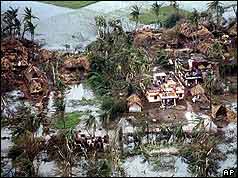The 1999 Super Cyclone was one which will remain in our memories as worst and deadly cyclone killing thousands of people and and millions of houses collapsed, washed away. Initially it started on 16th October 1999 and then the second time it hit around 29th of October.16th October was not that severe as it was on 29th October
When this cyclone occurred I was there in the house alongwith my nephew. My brother’s family was staying nearer to my house. No one predicted this magnitude of cyclone with speed crossing 240 kmph. That time we did not have that many facilities that we have now. Communication-wise also mobile phones are introduced and motorola phone which is very big and must be wighing at least 300 gms and above.
The day the cyclone started initially the wind and rain was normal and slowly slowly the wind speed was raising. All the doors and windows were breaking and some rooftops, water tank cover were also flown away.
No lights, no water, no food and people were struggling to get water from government sent big water tanks. People were in bee lines. In this situation all were equal – no one big whether that person is an IAS, IFS or IPS or a Minister- everyone were to stand in a long ques.
My nephew and I were in the house eating whatever availble. We used to have small radio of pocket size and we were listening to get update on the cyclone.
We used to have lot of trees and all places in Bhubaneswar was greenery until this cyclone. One can hardly see any trees after the cyclone.
Whatever saved water we tried to manage as there was no power for several days as all the electrical polls fell down and all connections cut off and transformers were burnt. Food was a major problem as shops are running stock of whatever available with them.
My family members were worried as they were staying 500kms away and they were not affected by the cyclone. This cyclone hit mostly the coastal belt.
At that time since i used to work for Oxfam UK, an international developmental organisation, which responds to natural calamities in addition to normal developmental activities supporting NGOs. Though no communication available we had to go to office after a day or two of the calamity. I stay in Sailashree Vihar and our office used to be in Jaydurga Nagar in Cuttack Road which is about 13 kms distance. So, we have to reach the office by hook or cook as we are one of the pirmary agencies which response to emergencies across the globe. I started from my house in the morning by walk as all the roads are blocked with trees fell on the road, and i had to venture crossing these trees. Finally with much difficulty i reached the office and so as others who are around. We had emergency meetings as to how we can help in immediate relief. Since no communication, we had to camp at the Chief Ministers office where only some satellite facilities were available. Like Oxfam many international agencies and local agencies, government officials used to camp in the CMs office and that time Giridhari Gomongo was the Chief Minister. I along with one or two other colleagues used to sit there day and night as we used to get communication i.e. FAX messages, calls from Oxfam UK and other Oxfam offices who were arranging emergency relief. We used to survive with whatever available to eat – bananas, biscuits and so on. sometimes we had to manage with water – the situation was like that at that time.
Meantime staff were given the responsibility of arranging rotis and chura,Gur, candles,match boxes, sanitary items etc. But the first distribution that we did arranging food packets to airdrop them. As far as I am concerned, i went around hotels small and big in Sailashree Vihar and requested them if they can arrange food packets which contains rotis sabji etc. Since no wheat was available it was difficult and many hotels are closed and even they did not sell. However, i contacted one small hotel and since they had wheat flour etc. they agreed to provide roties etc and pack them. If i remember, they could manage to pack about 1000 or so packs and I can’t exactly remember. These alongwith other food packets arrnaged by others were sent for air dropping.
We had meeting of all NGOs who came to provide help for which Oxfam provide finances. I used to handle the cash and used to provide cash alongwith signing of letters. These were instantly approved by the Oxfam’s head in Bhubaneswar.
In addition to this there were co-ordinating meeting called by Government and other NGOs to ensure that all affected people get relief so there they decided which village, which block, which district which are the ngos are going to provide the relief and accordingly Oxfam and some other relief agencies also provide financial support. After distribution the NGOs comeback with vouchers and whatever details they could have as far as distribution is concerned they used to provide and they used to take the balances funds for further relief as these were done on reimbursement basis.
Within 48 hours Oxfam UK has sent in a large cargo with relief materials which includes everything starting with first aid to water tanks shelter kits, utensils with engineers, doctors, water and sanitation experts, livelihood experts, shelter experts – we had to hire huge godowns and some we found in Macheswar industrial area and some in some other locations. The Oxford team also came with a number of satellite phones. The teams went to all the affected areas in cor-ordination with Government officials and other NGOs. For all the hundreds of foreign experts we had to find accommodation and we hired many available apartments in Rasulgarh and other areas.
Continue in the next post of the rehabilitation measures…
